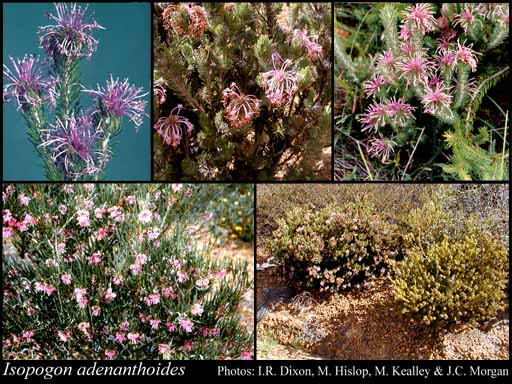- Reference
- Hooker's J.Bot.Kew Gard.Misc. 7:69 (1855)
- Conservation Code
- Not threatened
- Naturalised Status
- Native to Western Australia
- Name Status
- Current
Erect shrub, 0.3-1 m high. Fl. pink-purple, Jun to Oct. Sand over laterite, gravelly soils.

Scientific Description
Shrubs, 0.5-1.5 m high; branchlets hairy, with straight hairs or with curled hairs. Leaves alternate, 10-25 mm long, 0.7-1 mm wide, hairy; lamina terete, more or less the same width throughout, once divided, tripartitely divided, entire or divided to the midrib, straight or curved, 0.5-1 mm long, with 3-4 points or lobes; distance from base of leaf to lowest lobe 3-8 mm. Inflorescences not viscid, pink. Perianth 21-25 mm long, hairy, the limb apex hairy at the apex only; pistil 20-30 mm long; pollen presenter not fusiform, glabrous, 3-4.5 mm long, the brush 1-1.5 mm long. Cone with deciduous scales, 13-15 mm long. Flowers in June, July, August, September or October. Occurs in the South-west (SW) Botanical Province(s), in the Geraldton Sandplains (GS), Swan Coastal Plain (SWA), Avon Wheatbelt (AW) or Jarrah Forest (JF) IBRA subregion(s).
Distribution
- IBRA Regions
- Avon Wheatbelt, Geraldton Sandplains, Jarrah Forest, Swan Coastal Plain.
- IBRA Subregions
- Dandaragan Plateau, Geraldton Hills, Katanning, Lesueur Sandplain, Merredin, Northern Jarrah Forest, Perth.
- Local Government Areas (LGAs)
- Carnamah, Coorow, Dandaragan, Gingin, Irwin, Moora, Three Springs, Victoria Plains.